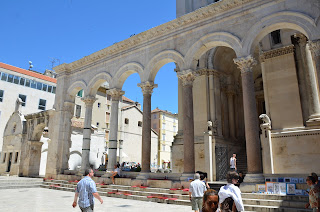Split is the largest city on the Dalmatia Coast. It is absolutely gorgeous. The terrain is quite rocky but still has a lot of trees. It is a major port. It also has factories located along the coast that were built during the communist rule. Tourism is a big part of their economy. Our guide, Ante, is from Split. He teaches English classes during the school year and conducts tours during the summer. He has been fantastic. He is very knowledgeable and is very personable. He has taught us so much.
The most famous land mark is the Palace of Diocletian. It was built by Diocletian who was the Emperor. It took 11 years to build which was remarkably fast for that time. It is said that he had over 4,000 slaves work on it with over 2,000 slaves dieing while working on the palace.
This is the outside wall of the palace. It has been converted to shops so it doesn't really look like a palace on the outside. If you look closely you can see how old the building looks and that the top floors look very old.
Entrance to the Palace
This is one of the entrances into the palace. This entrance leads you into a hall that will take you to the main square or down into the basement. They did not discover the basement until 65 years ago. People's trash went into the basement and eventually it filled up. The living quarters on the upper levels have been handed down from family to family and no one realized there was a basement.
This is a replica of what the Palace looked like. It has a city square, a Clock Tower, a Cathedral, Temple of Jupiter, Temple of Venus, and living quarters for the Emperor and his wife and daughter.
This is the basement of the Palace. The walls of the basement serve as a foundation for entire building. The walls are 6 to 8 feet thick.

A section of the basement that still needs to be excavated.
Sarcophagus
The Palace was built out of local limestone. The craftsmanship is amazing. You can see the arches that were used in the architectural design.
The basement rooms serve as a foundation for the rooms that were built above it. The rooms in the basement reflect the size of the room on the floor above.
Beehive Ceiling
Rounded walls.

The Cathedral of St. Domnius
Entrance to the Cathedral. The cathedral faces the City Square.
This was what we would think of as the Performing Arts Center.
Looking down into the city square.
Looking down into the city square.
You will notice that the columns ont he right are darker. They are made of precious materials and were stolen from Egypt.
These are acapella singers that sing in the palace. Even though there are only four men singing, they sound like an entire choir. The buildings provide great acoustics for the singers.
This is St. Gregore. There is a tale that if you touch his toe and make a nonmaterial wish, your wish will come true.
Lynn is going for the wish.
Northgate of the Palace.
View from the outside of the northgate to the Palace.
Westgate to the Palace.
Narrow streets of the Palace. The streets are lined with little shops and cafes.









